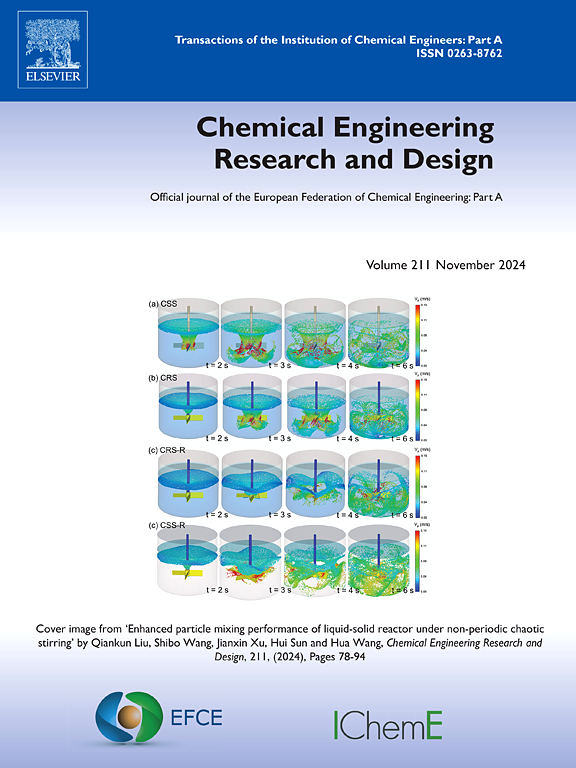基于多孔介质的煤热解外加热固定床反应器的数值模拟
IF 3.9
3区 工程技术
Q2 ENGINEERING, CHEMICAL
引用次数: 0
摘要
利用多孔介质开发了一种先进的三维瞬态模型,用于精确模拟外部加热煤炭的热解过程。这一创新模型全面考虑了水的蒸发和凝结以及挥发物的释放。此外,它还细致地研究了煤层孔隙率的变化以及热解气体与固体煤层之间的相间传热。通过对实验反应器内中心温度演变的验证,模型的精确性得到了适当的确认。值得注意的是,该模型系统地说明了煤层温度、蒸发和水分密度、煤层密度变化、孔隙率分布、挥发物释放和相间传热等各方面的演变。结果表明,水分相变吸热使煤层温度在一段时间内相对稳定在水沸点附近,从而推迟了煤热解反应的开始。中心煤层热解释放出的热解气体在流出反应器之前往往径向流向加热壁。此外,在快速加热阶段,煤层孔隙率的变化使传热速率平均每分钟增加 1.5 °C。分析还强调了整个热解过程中相间传热的显著性,并阐明了其在不同阶段的机理。最终,这项工作为后续外部加热固定床煤热解反应器的设计、优化和扩展提供了重要的理论指导。本文章由计算机程序翻译,如有差异,请以英文原文为准。
Numerical simulation of an externally heated fixed bed reactor for coal pyrolysis based on porous media
A cutting-edge three-dimensional transient model utilizing porous media has been developed to accurately simulate the pyrolysis process of externally heated coal. This innovative model comprehensively considers the evaporation and condensation of water, as well as the release of volatiles. In addition, it meticulously examines the change in coal seam porosity and the interphase heat transfer between pyrolysis gas and solid coal seam. The model's precision has been appropriately confirmed through validation against the central temperature evolution inside the experimental reactor. Notably, this model systematically illustrates various aspects, including the evolution of coal layer temperature, evaporation and moisture density, changes in coal layer density, porosity distribution, volatile release, and interphase heat transfer. The obtained results reveal that the heat absorption by moisture phase change causes the coal seam temperature to relatively stabilize at around the water boiling point for a period, thus delaying the initiation of the coal pyrolysis reaction. The pyrolysis gas released by center coal seam pyrolysis tends to flow radially toward the heating wall before flowing out of the reactor. Additionally, the change in coal seam porosity increases the heat transfer rate by an average of 1.5 °C/min during the rapid heating stage. The analysis also highlights the significant occurrence of interphase heat transfer throughout the pyrolysis process and elucidates its mechanism in various stages. Ultimately, this work offers essential theoretical guidance for the design, optimization, and scaling of subsequent externally heated fixed-bed coal pyrolysis reactors.
求助全文
通过发布文献求助,成功后即可免费获取论文全文。
去求助
来源期刊

Chemical Engineering Research & Design
工程技术-工程:化工
CiteScore
6.10
自引率
7.70%
发文量
623
审稿时长
42 days
期刊介绍:
ChERD aims to be the principal international journal for publication of high quality, original papers in chemical engineering.
Papers showing how research results can be used in chemical engineering design, and accounts of experimental or theoretical research work bringing new perspectives to established principles, highlighting unsolved problems or indicating directions for future research, are particularly welcome. Contributions that deal with new developments in plant or processes and that can be given quantitative expression are encouraged. The journal is especially interested in papers that extend the boundaries of traditional chemical engineering.
 求助内容:
求助内容: 应助结果提醒方式:
应助结果提醒方式:


